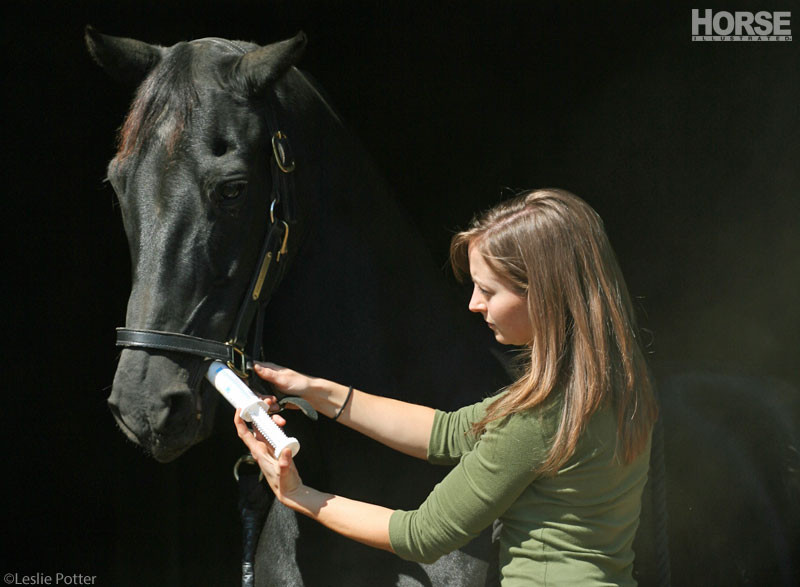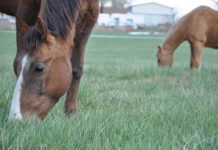
Fortunately, there are many ways to help the medicine go down. Here are some resourceful techniques, but before you try these or any other methods, always ask your vet if the pills can be crushed, or dissolved in a small amount of water, or if they must be administered whole. Don’t assume you can grind or dissolve your horse’s meds and add them to his feed; time-release pills sometimes have to be delivered to his digestive system intact. Find out before you proceed.
If powdering the pills or dissolving them is acceptable, ask if there are safety factors you should know about. Some horse medications can be toxic to humans when inhaled or absorbed through bare skin, especially over prolonged periods of time. It’s always wise to wear latex gloves while processing medication, but your vet may suggest more stringent measures depending on the potential toxicity of the medication involved.
Grind It Up
If your vet prescribed a powder medication, or you’re grinding up pills, you will want to mix it with feed or dose it from a syringe.
To efficiently reduce horse pills to granules or powder, use a mortar and pestle (available at kitchen supply or import shops and from food co-ops selling herbs) or a small electric coffee grinder. Whichever you choose, reserve your pill powdering apparatus for veterinary use only. Clean it by scrubbing it in hot, soapy water.
To break up large, hard pills before grinding, tuck them in a small paper envelope, stick that inside a plastic sandwich bag and whack the pills with a hammer. Powder only enough pills for a single dose and process them just before dosing.
|
Feeding Powdered Pills
Anyone who’s medicated horses knows how frustratingly fussy some are about accepting doctored feed. Still, yours can probably be conned into doing it. The trick lies in discovering a carrier food he likes. Try blending his powdered medication with mashed, cooked carrots or with applesauce and stir the mix into his grain. He has asweet tooth? Add powdered pills to crushed after-dinner mints, pancake or corn syrup, molasses (or molasses whipped with brown sugar) or honey. Powdered fruit-flavored Kool-Aid that’s premixed with sugar tempts many horses. So does yogurt in fruity flavors. And many horses adore peanut butter.
Does your horse greedily chomp hand-fed treats? Quarter an apple and set three of the quarters aside. Cut a deep slash in the fourth quarter, pack it with the crushed or powdered pill and press the edges shut. Feed your horse two of the plain quarters, then slip him the doctored piece, rapidly chased by the third unadulterated quarter. It works nearly every time.
If you feed your horse sweet goodies, try this messy but effective trick: Stir powdered medication into a glop of canned cake frosting and let him lick it off of a flat surface, like a portable cutting board. It’s safer than hand feeding.
Medicated carriers blend well with sweet feed, and the sweetness helps mask bitter flavors, as does alfalfa molasses. Unless you’re positive your horse will accept doctored feed, only add a dollop of medication/carrier mixture to just a moderate amount of feed—don’t overwhelm him. Be sure to thoroughly blend whatever you use into the feed, rather than drizzling it on top. After your horse cleans up the spiked feed, you can give him the rest of his ration. Allow him three hours to consume medication-laced feed. Then, if a significant amount remains, remove it and try a different carrier. If you’re not certain whether his medicated feed is being consumed or scattered, consider feeding it from a nosebag.
Syringe Dosing
If your horse rejects medicated feed, try dosing ground pills or powdered medication through a syringe. To do so, blend the powder into no more than two ounces of runny, goopy carrier. Good ones include finely pureed baby foods like carrots or applesauce, fat-free yogurt (it’s stickier than the low-fat kind; smooth vanilla, lemon or coffee flavors work well), sugary syrups or molasses, or smooth peanut butter liberally thinned with vegetable oil.
Load the spiked carrier into a catheter-tip irrigation syringe (get it from your vet or local tack and feed store) or an empty large-volume, single-dose paste deworming tube you’ve scrubbed in steaming, sudsy water and rinsed thoroughly. Administer the dose as though you were paste deworming your horse, taking care to squirt all medication well back on his tongue. As soon as you’ve emptied the syringe, grasp your horse’s jaw and elevate his head. Hold it up until he swallows.
Dosing By Hand
If your horse is willing, you can give an intact pill by hand when necessary. However, if your horse is on medication for the long term, he may eventually begin to refuse this method. To dose a horse by hand, stand alongside him, facing him. Insert your fingers into the bars of his mouth. When he opens his mouth, reach in and grasp a fistful of tongue.
|
Hold tight. Coax the tongue down and out the side of his mouth. His mouth will gape open. Place the pill as far back on his tongue as you can, taking care not to snag yourself on his teeth. Now quickly release the tongue. This will carry the pill to the back of his throat where he’ll gulp it down.
Shoot It Down
Not crazy about sticking your arm inside a horse’s mouth? Neither was the soul who invented the balling gun. This plunger-fitted tubular implement is often used to propel pills down large animals’ throats, particularly cattle. Ready-made metal or plastic balling guns can be purchased from veterinary supply catalogs, but you can easily make your own (see “Make Your Own Balling Gun” pg. 95). To use any of these tools, draw back the plunger and insert a pill in its open end. Hold it so the pill doesn’t slide out. Elevate your horse’s head and with or without extracting his tongue, insert the implement into his mouth up to the base of the tongue and zap the pill down his throat. (Never insert a balling gun farther than the base of your horse’s tongue. Ramming it into his throat can cause serious, permanent damage. And never administer large, whole pills or halved pills to Minis or foals.)
It may take some trial and error to find the best method of getting the medicine to go down, but with a little creativity—it can be done.
Liked this article? Here are others you’ll love:
Video: Administering Eye Medication
Deworming the Reluctant Horse
Sue Weaver is a freelance writer from Arkansas.
This article originally appeared in the February 2004 issue of Horse Illustrated. Click here to subscribe.







I have been told that using a balling gun on horses is a bad idea.
Wow! thank you sooo… much for this article! I am so glad I read this! Great info. I never would have thought of some of the ways you sugested to give meds. I look forward to more informative articles. Thanks again.
I find that it is easier to give horses medication mixed in with foods. When I have a powdered substance, I will mix it with sweet feed and then add corn or vegetable oil to the mixture. My horses cannot tell the difference.
Good Article
Re feedinf meds.
I like to pre condition foals with a sryinge and apple sauce. I have one foal who has had such a nasty time with scours that now when you walk out in the field bounces up to me and opens his mouth to get his “treat” and is offended when he does not get it . I also feed powderd gaitor aide by hand from time to time.
For every horse I worm first I teach them to accept the syringe. I get a syringe and a tasty pre-packaged fruit or apple sauce and just sit there and give it to the horse until it willingly allows me to stick the syringe in it’s mouth. I do this every day for a few weeks prior to the scheduled worming or medication. First I use a syringe full of warm water. This makes the horse expel anything stuck in the cheeks and makes the pallet wet so no medication or wormer can stick to it. I then administer the dose and never have a problem with them trying to spit it back out because it doesn’t stick.
excellent article
Great article.. very informative
I rather leave it to my vet…
Helpful! You have everything- Do this…if that doesn’t work…if THAT doesn’t work..IF THAT DOESN”T WORK… all the way down to the last drop. Good for people who have trouble, or are squemish about the Medicine
good info
I have appreciated your article on alternative ways to administer medications to my horses. Most useful article.
Thankyou
these are great tips
Great suggestions. I gave my Tennessee Walker yogurt to help his stomach while he was being treated for Limes (90 pills per day for 30 days.) Luckily, he thinks with his belly so it worked great. Made his hooves grow too.
great rips!
I am glad I never had to give Grey medicine, but she hated the wormer… I just grabbed her nose and instered the wormer a bit at a time and then she did really well after that. I like the tips, but what a lot of work.
Great tips.
Avoid pulling hard on the toung though! It can cause severe damage to a bone that it is attached to in the back of the throat.
These tips are Great,if you have never tried them before.I have a Mare that was struck by a car…on her owm property.I had to give her Med’s by mouth.She grew so tired of this method,as did I,that when she see’s me coming with the wormmer,well you know the rest of the story.It’s not Happening.Anymore Suggestions?
These are great tips!
great tips
Good tips. I almost always give my horses medication myself, saves on vet costs too.
great information. thanks
needed an article like this! Thanks!
This was a very helpful article!
Great Article
NOW I WILL BE ABLE TO HELP THE BARN BECAUSE A HORSE NEEDS TO TAKE MEDS SO KNOW I CAN GIVE THEM THESE TIPS AND I CAN HELP THEM
Boy, I can really learn something new everyday on Horse Channel.
Sounds like so good tips and tricks.
I mix mine medicine is a small amount of water to the point it falls apart, then add applesause.
Goof advise, but some time it is not so easy…horses do not read these articles.
Thanks for the tips, I am so thankful I have not had to give my horses anything but wormer and vaccines. I am thankful my horses are healthy
Jello works great to mix with dry meds.
Great information.
Jello? Can horses have Jello?
Did you know that Jello is made by boiling it in animal bones? It’s disgusting!
Thanks so much for the helpful advice! i have to give my Mini horse powdered Meds.
I’m hesitant to agree that cake frosting is fine to give to horses . . . .
Great article. Thought I knew lots of tricks, but you have added some more to my repetitore! Thanks!
Great info! Thank you for all the tips!
great information
This is great information. Thank you
Excellent!
hhmmmmmm
I LOVE LOVE LOVE Horse Channel!
How do I administer medication under my horses tongue?
Useful information:DI’m so glad horse channel is here!
Good article! I use the syringe method to administer Bute powder and figured out how to fill it easily. Remove the plunger. With finger over the tip, fill from the open end: 1 oz light Karo corn syrup; use a small funnel in the open end and pour in the dosage of Bute powder (one scoop (1 oz) for my 1000 lb horse). Tap the funnel until all powder goes into the tube. Add a little water (about 2 tablespoons), insert the plunger to block the top, turn the syringe with the tip up and let the air rise through the tip (it will push out a little of the corn syrup.) Push the plunger in a little more, put your finger over the tip and shake thoroughly. My horse comes willingly when she sees this treat. I don’t even need to put a halter on her as she will stand there and slurp every last bit. I make sure to put the syringe in the side of her mouth, otherwise she bites the syringe and tries to take it away from me. I wash the syringe in hot water and reuse as long as it’s in good shape. If the plunger gets to where it doesn’t slide easily, I use my finger and wipe a little vegetable shortening inside the syringe tube, before filling it. Works like a charm!
Great article!
Wow. I never knew about this. Thanks for the info